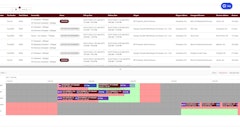It used to be that blueberries, grapes and other perishables aboard ships from Peru and Uruguay steamed right by South Florida ports to Philadelphia. Then the fruit was sent back down the coast to local supermarkets, hotel banquet tables and restaurants.
Because of a decades-old cold-treatment process designed to prevent infestations by the Mediterranean fruit fly and South American fruit fly and their spread to warmer climates, U.S. rules required certain fruits to enter at cooler northern ports above the 39th parallel.
But now a pilot program that began last October means fruit from Peru and Uruguay no longer has to go north to head south again. It can be treated aboard ship if the voyage is long enough to complete the 15-day process, at a trans-shipment port or in its country of origin and then sent directly to PortMiami and Port Everglades.
When it comes to perishable produce, speed is everything.
Seaport officials say that when produce comes directly to South Florida, it can be on supermarket shelves five days faster than if it went via ship to Philadelphia and was trucked back here. That contributes to longer shelf-life, better quality and lower costs.
Right now the U.S. Department of Agriculture trial, which runs for an indefinite period, only covers grapes and blueberries from the two South American countries but it's possible other commodities and other countries will be cleared for direct shipments to South Florida.
"It's been a great program so far. I think there will be some expansion in the future," Abel Serrano, a U.S. Customs and Border Patrol supervisor at PortMiami, said during an International Perishables Conference in Miami.
A pilot program for the Port of Savannah, which will allow direct shipments of South American citrus, grapes and blueberries that have already undergone cold treatment, was announced early this month. It's set to begin Sept. 1.
Protection against imported pests is serious business in Florida because many insects from warmer climates can thrive here. Safeguarding the citrus industry from destructive pests also is crucial.
USDA rules on treatments for imported produce vary depending on the pest and where a shipment is coming from. Chilean grapes, for example, don't undergo cold treatment because the South American country has been declared Medfly-free. Asparagus from Peru must be fumigated, and mangoes from Haiti and Peru undergo a hot-water treatment.
PortMiami received its first direct shipment of Peruvian blueberries in March aboard an APL ship.
Since the program began, PortMiami has received 16 containers full of Peruvian grapes and smaller shipment of blueberries, said Juan Kuryla, PortMiami director.
"There's a lot of excitement in the marketplace about this program,'' said Kuryla. "The program is working; the safety component is working."
So far, he said, there's only been a problem with one shipment and that was due to a paperwork error.
Shortly after the pilot program began, PortMiami launched its Faster is Fresher campaign to encourage growers and shippers to send their produce through Miami, but Kuryla said there's still a lot of outreach to do to raise awareness that the rules are different now.
In practice, much of the fresh fruit from Latin America and the Caribbean still goes to Philadelphia because the northern port can handle large volumes and has many refrigerated warehouses and treatment facilities.
But Eric Olafson, the Miami port's manager of cargo development and intergovernment affairs, says he's been busy getting out the word that Miami-Dade has 230 million square feet of warehouse space and that nine new Class A warehouses are being built.
But refrigerated warehouse space is harder to come by. Currently there are only about 300,000 square feet of refrigerated and freezer warehouse space available for purchase or rent in Miami-Dade, said Edward Redlich, vice president of ComReal Miami.
Ellen Kennedy a spokeswoman for Port Everglades, also gives the pilot program for Peruvian and Uruguayan fruit high marks. "It's been going very successfully,'' she said.
The program is potentially important for Port Everglades because refrigerated containers loaded with produce are a big part of the port's cargo mix, said Kennedy. Last year Port Everglades handled 129,203 refrigerated TEUs -- the equivalent of standard 20-foot containers. That's more than double runner-up Jacksonville and third-place Miami at 58,618 TEUs.
So far both ports have imported only small quantities of fruit under the trial program, but they are eager to expand as produce gateways.
"People want fresh now,'' said Olafson. "I remember when I was growing up you used to get those cans of peaches and fruit cocktail."
As more perishables are transported in refrigerated containers, rather than on pallets in refrigerated ships known as reefers, it's easier to control pests. "Now everything is in a box or a sealed container. There's not the danger of something flying off a ship,'' Olafson said.
New technologies also are making ship transportation of some perishables, such as imported fresh fish and even flowers, feasible, Olafson said. Such products have been moved almost exclusively by air.
Port officials aren't the only ones who see South Florida's potential as a perishables gateway.
Flagler Global Logistics' new intermodal South Florida Logistics Center hopes to play a big role in the growing fresh produce trade.
Opened last November, the South Florida Logistics Center sits on 200 acres near Miami International Airport that was part of the Hialeah rail yard. For years, the site was used to store thousands of cars that were in transit.
But the parcel, which has room for two million square feet of industrial space and rail links to both seaports, was too valuable just to have cars sitting on it, said Chris Scott, president and chief executive of Flagler Global Logistics, which is owned by Florida East Coast Industries.
"Our focus initially is perishables," said Scott. "Obviously there's a big opportunity to create a supply chain process so a ship doesn't pass us by and then a truck comes back down to Florida."
Since opening its refrigerated storage space, which is kept at around 35 degrees, the center has handled blueberries, asparagus, citrus, apples, avocados, ginger and Chilean grapes. It also helped some Miami companies handle their overflow of Valentine's Day flowers.
For produce that requires fumigation, which is different from the cold treatment process, the center has facilities on site. Ninety-five percent of the fumigant it uses is recaptured so it isn't released into the environment, Scott said.
"Flagler is able to get produce right off the ship, fumigate it on site and then pack produce in plastic clamshells or bag it right at their facility," Olafson said. "It has state-of-the-art refrigeration and fumigation chambers.''
A new Flagler warehouse with refrigerated space is expected to be ready in November or December -- just in time to handle a seasonal influx of berries from Chile and Argentina, and another warehouse is expected to be completed in late summer.
Flagler hopes to have the entire South Florida Logistics Center industrial complex built out some time in 2016 and will be subleasing part of it.
"Five years from now, this will be a busy industrial park vital to what we do at South Florida airports and seaports," Scott said.




























